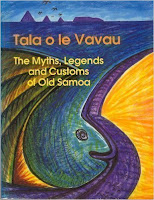Samoa was not an easy choice. The first two books I found were intriguing, but written by linguists and ethnomusicologists who collected tales on the side. I learned a lot from them, but they only had a few stories, and a whole lot of scientific text to dig through. The third one proved to be a lot more reader-friendly, so I chose that for today's post.
Tala o le Vavau
The myths, legends, and customs of Old Samoa
C. Steubel & Bro. Herman
Polynesian Press, 1987.
This edition of the book claims that the stories had been completely re-written by Samoan scholars, which is definitely a plus (especially considering that aitu spirit tales are still grouped under "Demons"). The book is bilingual, presenting the stories in Samoan in the first half, and in English in the second. It contains 34 stories, and a sizable chunk of "customs" at the end (things such as weddings, social ranks, crime and punishment, etc.). It was a short read, but an interesting one.
Highlights
 |
| Picture from here |
One of my favorite stories in the book was the legend of Tiitii-a-Talaga. In this, Tiitii followed his father to see where he worked in secret, and found that his gardens were inside the mountain where the god of earthquakes lived. The boy fought the god, defeated him in wrestling, and then stole fire from him to give it to the people. Later, he also killed a giant octopus. Another intriguing story was that of King Mailetoa, a cannibal king who ate two strong young men a day, until his own son offered himself as sacrifice, changing the father's mind. The story reminded me of the Persian legend of Zahhak a little.
There were also smaller things I liked in the stories. For example, I really liked the goddess who picked a husband based on how well her name harmonized with his - she was called Mataiteite, and she chose a man named Matatalalo. Another fun moment was the one where a giant octopus spirit moved into a cave by a stream; when a pregnant woman went into labor while bathing, the spirit and all its companions fled, horrified by the sight of childbirth...
Connections
There was a part in the legend of Nafanua that reminded me of the myth of Eros and Psyche. A girl was visited at night by her husband, but he always left before dawn; one day she decided not to wake him, and in the morning light she saw that he had a cock's comb. The husband fled, and so did the girl.
It should be self-evident at this point that Samoa, like all the other islands, also has a legend about the origin of coconuts. In this one, a giant eel stalks a girl with his love, until he is finally captured and beheaded - and from the head grows the first coconut palm (no Maui involved this time). I also found a version of the popular story of the origin of the kava plant, in which people recognize the effects of kava by watching a rat chew on its roots and get drunk. And, of course, this collection, like most others from Oceania, contained a legend about where people's spirits travel after death.
Where to next?
Next week we arrive to New Zealand!










No comments:
Post a Comment